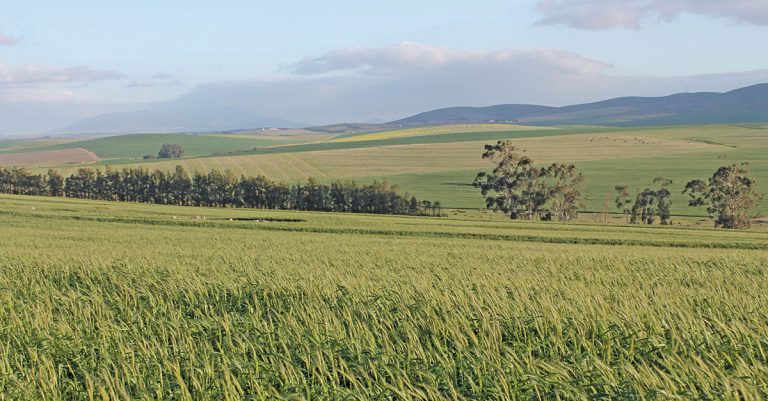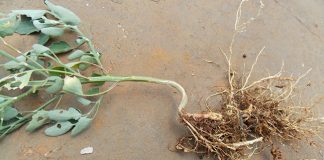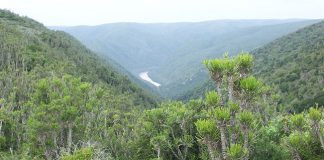
Photo: FW Archive
Maize is the most important field crop in South Africa, making up more than 50% of the country’s total field crop production.
The use of improved seed technology and sustainable farming practices have both contributed significantly to the management of pest and disease damage to maize crops.
However, the industry remains vigilant about the emergence of new threats to the production of this staple crop.
Return of an old foe
During the 2020/21 production season, several cases of maize eyespot, which is caused by the fungus Aureobasidium zeae, were reported in a number of production regions.
These were the first known cases of the disease since it was initially recorded in the more humid production areas of the south-eastern Free State, northern KwaZulu-Natal, and south-eastern Mpumalanga during the 1992/93 season.
Dr Bradley Flett, senior plant pathologist with the Agricultural Research Council’s (ARC) Grain Crops Institute, says that during the 1993/94 season, eyespot was more widespread and its severity greater, particularly in the Heidelberg district.
He adds that the fungus prefers cool, wet climates, which are not commonplace in South Africa’s main maize-growing region, the central and northern parts of the Free State. There was, however, some evidence this season of the disease also occurring in these areas.
According to Flett, in most cases where maize eyespot affects the leaves of the plant while in its vegetative state, two to four weeks before flowering, the symptoms are not severe and control is not warranted. The effect of the disease is most severe when it occurs on the upper leaves of plants approaching maturity.
Because the upper leaves are necessary for effective grain fill, minor yield losses can be expected when these leaves become severely infected.
Initially, symptoms appear as small (between 1mm and 2mm in diameter) circular to oval lesions that are cream to brown in colour and surrounded by a narrow halo. These lesions can coalesce to form larger necrotic regions on the leaves.
“In the cases reported this season, the symptoms weren’t very severe and yield losses were highly unlikely. However, I’m aware of farmers who sprayed fungicide to control the disease.”
Control through crop rotation
Although cases of the disease have been encountered on previously cultivated lands and those where maize has never been grown, crop rotation can help reduce early infection, says Flett.
The recommended system uses a three- to four-year interval for maize production on the same land. However, this is impractical in South Africa, where maize is the primary crop grown, and other crops are planted in rotation.
Due to the economics of maize production, many South African farmers insist on planting the crop in a monoculture system, which favours disease development.
The amount of infectious material can be reduced by rotating with crops that are not hosts for eyespot, as well as thorough ploughing and destruction of post-harvest residue, particularly that of seriously infected plants, says Flett. Deep ploughing of crop debris prevents sporulation (spore production) and promotes decomposition, which limits early-season spread.
Host plant resistance to A. zeae is important in the control of eyespot, and Flett recommends planting maize hybrids with some resistance to the disease. South African hybrids have not been screened specifically for resistance to maize eyespot, however, due to the relatively few outbreaks of the disease.
Chemical control of eyespot
Flett says that fungicides registered for use against eyespot include mancozeb, propiconazole, chlorothalonil and benomyl, which can be used when the disease becomes an epidemic and its severity is very high.
Some researchers have suggested that seed treatment can be effective in protecting against A. zeae. Should the disease reach epidemic status, spraying the plants at the early stages of disease development, when 1% or less of the leaf area is infected, will limit further infection. More than one application may be necessary when conditions are favourable for disease development.
“The use of fungicides against eyespot can be prohibitively expensive,” cautions Flett. “The role of fungicides has not been adequately researched, and some findings appear to contradict others.”
In his opinion, the role of fungicides in the control of eyespot requires further study to confirm their efficacy, economics, and when to spray.
To date, the low level of the disease’s severity on plants has not warranted spraying of fungicide. Farmers are urged, however, to regularly monitor fields that show signs of infection and approach their local plant pathologist or send samples to the ARC’s Grain Crops Institute for further advice.
Wheat diseases
Wheat is the most widely planted grain crop in South Africa’s winter rainfall production region, and the second-most important grain crop in South Africa. According to Dr Gert van Coller, a plant pathologist at the Western Cape Department of Agriculture, the main disease threats to wheat vary from one year to the next, and are highly dependent on weather conditions during the growing season.
Powdery mildew and Fusarium crown rot are both well known in the Western Cape, where they have occurred for many years.
Powdery mildew
Powdery mildew occured at near-epidemic levels in the Western Cape during the 2018 and 2019 production seasons, but was almost absent during 2020, explains Van Coller.
Nonetheless, it remains a major concern, as a favourable climate, coupled with the disease’s polycyclic nature (able to complete many life cycles in a season) can easily result in an epidemic.
Powdery mildew is visible as whitish, fluffy patches on leaves and stems of wheat plants.
“Infection by the causal fungus can occur any time during the growing season, on any above-ground part [of the plant], if the climate is conducive to the disease,” says Van Coller.
These fluffy patches, called mycelia, are the matrices of fungal hyphae (the threadlike filaments). Later in the season, the fluffy patches become a brownish colour. Black specks, which are the fruiting bodies of the fungus, then become visible.
According to Van Coller, the fungus that causes powdery mildew (Blumeria graminis f. sp. tritici) is a true parasite that gets its nutrition directly from the wheat crop, reduces its photosynthetic ability and increases its respiration, which leads to reduced yield.
Early-season infection can reduce the number of secondary tillers and heads that develop, and the disease is especially damaging when the flag leaves and heads become infected. Infected kernels are sticky, with a reduced grain quality.
Treatment
Powdery mildew can be managed by spraying with fungicide and planting more resistant cultivars. Chemical control is important, but it must be applied timeously, stresses Van Coller, as it is ineffective when applied too late.
Planting resistant cultivars has been shown to reduce incidences of the disease in other countries, but not much is currently known about resistance of local cultivars.
“While crop rotation with broadleaf crops is important, since it allows time for the stubble that hosts the pathogen to break down, remember that the fungal spores can travel for many kilometres on the wind; your wheat fields can therefore still become infected from spores originating from other fields,” he says.
Van Coller adds that wheat monocropping is an undesirable practice, as it places wheat seedlings in the vicinity of infected stubble. In addition, farmers should avoid over-fertilising with nitrogen, since it has been shown to increase disease levels.
Crown rot
Fusarium crown rot (FCR) becomes visible only at the grain-filling stage: the stalks and heads are white (dead), and contain little to no grain.
“FCR looks very similar to another important wheat disease called Take-all, but can be identified by carefully uprooting symptomatic plants, washing soil from the roots, and stripping the leaves from the stems,” says Van Coller.
While Take-all causes extensive root rot, FCR does not infect the roots. It is visible on stems, once the leaves have been removed, as a dark honey-brown discolouration that extends from the lower stem upwards. It is, of course, possible for both diseases to occur simultaneously on the same plant.
During periods of above-average rainfall, the white stalks and heads caused by FCR may be less common, although stem infection will still be visible.
The fungi that cause FCR (Fusarium pseudograminearum and, to a lesser extent, F. culmorum) infect the plant via the lower stem area, including the crown region and sub-crown internode, and as mentioned, the stem rot progresses upward.
Obstructions form in the xylem and phloem tissue and disrupt water absorption from the seminal roots, which makes the plant dependent on the shallow crown roots for its water absorption.
“Although actual numbers with regard to the impact of FCR on grain yields in the Western Cape are still lacking, we’ve proved a significant negative correlation between disease incidence and yield, meaning that as [the number] of incidences of the disease increases, the wheat yield decreases.”
Treatment
According to Van Coller, FCR is best managed with crop rotation using broadleaf crops such as canola, lupins and medics, as these are not hosts for the pathogen.
Crop rotation allows time for the stubble, which hosts the pathogen, to break down, thereby reducing the disease pressure. And, while a conventional tillage practice such as ploughing does reduce the stubble, this practice is not compatible with conservation agriculture.
“The use of foliar fungicide is ineffective against FCR, although seed treatments with registered chemicals are essential for protecting young seedlings against infection. Seed treatments, however, cannot protect adult plants against the disease,” concludes Van Coller.
Email Dr Bradley Flett at [email protected], or Dr Gert van Coller at [email protected].











